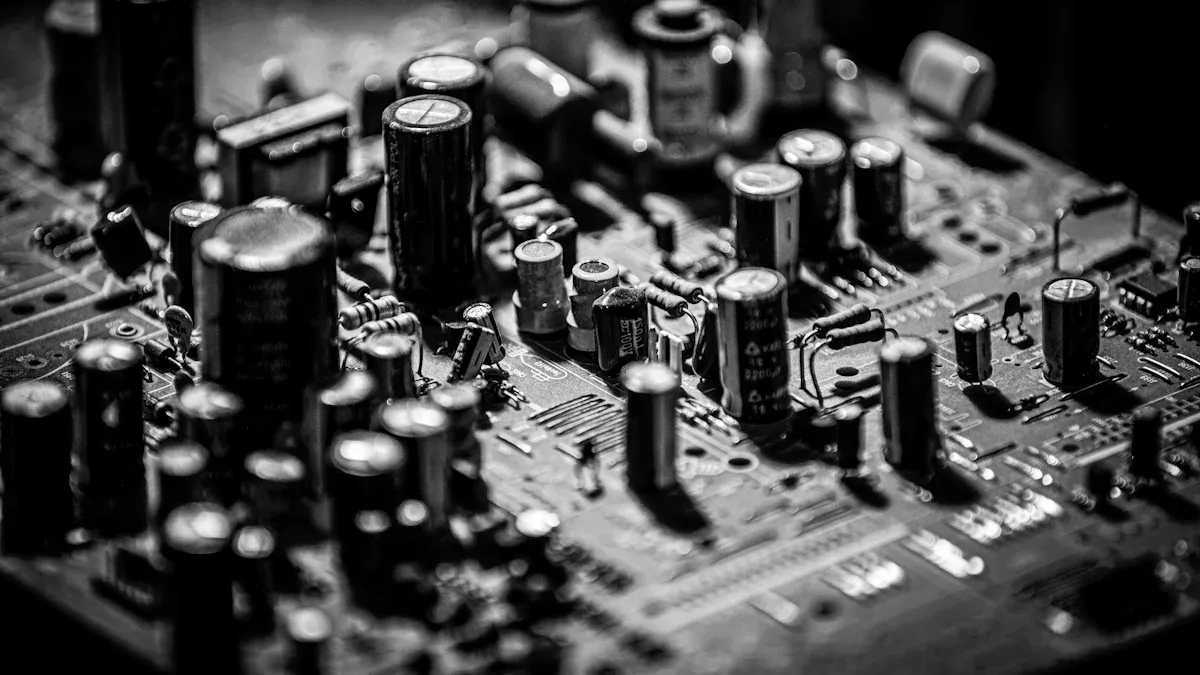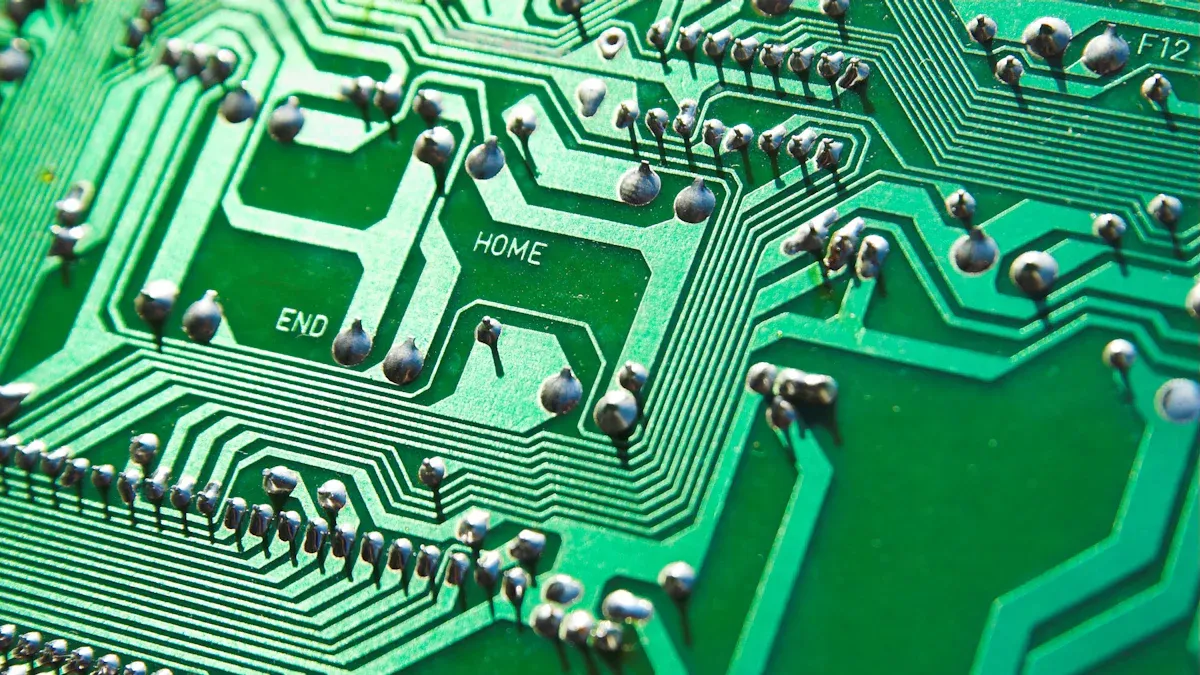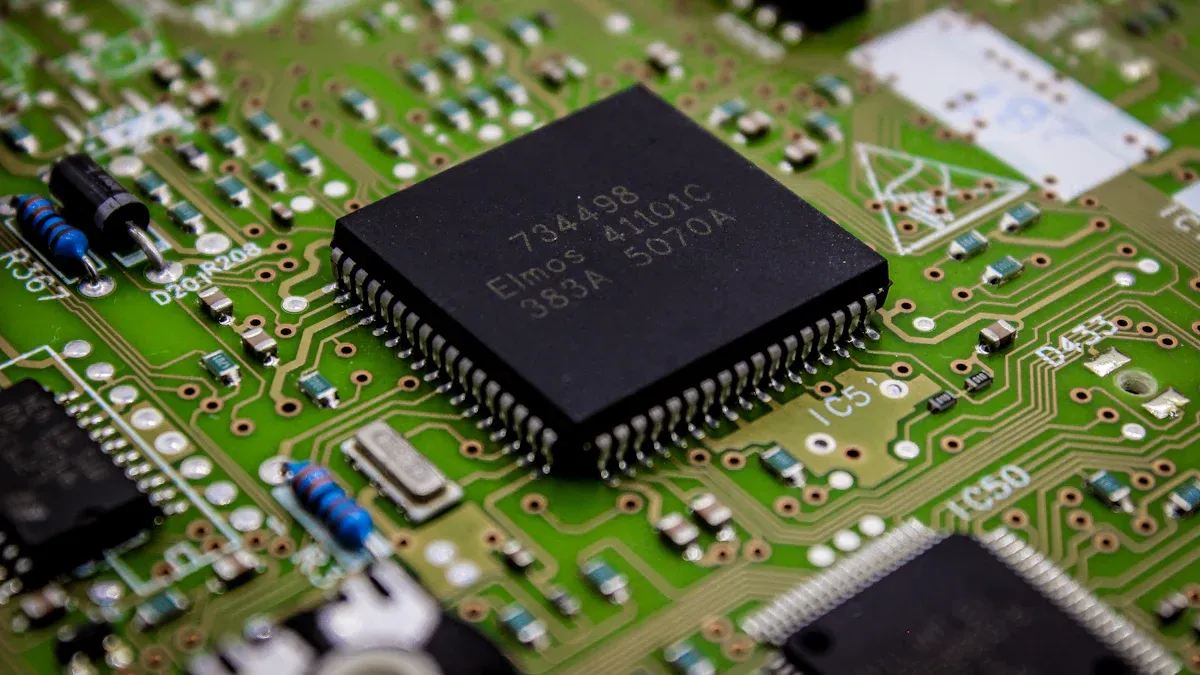What is a Current Controller Chip and How Does It Function

A current controller chip is a small integrated circuit that helps regulate the flow of electrical current in electronic devices. By managing current levels, it ensures your gadgets work efficiently and safely. These chips play a crucial role in protecting systems from overheating or power surges. For example, modern solutions like SiC MOSFETs have reduced energy losses by up to 44%, making them ideal for high-performance applications. With their ability to cut power consumption globally by 10 TWh annually, these chips contribute significantly to energy efficiency, powering nearly one million homes.
Key Takeaways
Current controller chips control electricity to keep devices safe. They stop overheating and power spikes.
These chips check, adjust, and balance current to stay steady. This keeps devices from breaking and makes them work better.
Buying devices with these chips saves energy. They use power smartly, cutting costs and helping the planet.
There are different kinds of current controller chips, like linear and switching ones. Each type works for specific needs, balancing ease and efficiency.
These chips are important in many areas, like cars and green energy. They help electric cars and solar panels work smoothly and perform well.
How a Current Controller Chip Works

Current regulation and its importance in electrical systems
Electrical systems rely on consistent current flow to function properly. When current fluctuates, devices can experience performance issues or even permanent damage. You might notice this in everyday electronics, like when a smartphone overheats or a laptop shuts down unexpectedly. A Current Controller Chip prevents these problems by regulating the flow of current. It ensures that your devices receive the exact amount of power they need to operate efficiently.
Without proper current regulation, electrical systems can become unstable. This instability can lead to overheating, short circuits, or reduced lifespan for your devices. By maintaining steady current levels, the chip protects your electronics and improves their reliability.
Tip: Think of a Current Controller Chip as a traffic officer for electricity. It directs the flow of current, ensuring everything moves smoothly without congestion or accidents.
Core principles: sensing, feedback, and adjustment
A Current Controller Chip operates using three main principles: sensing, feedback, and adjustment.
Sensing: The chip constantly monitors the current flowing through the system. It uses sensors to detect changes in current levels, whether they are too high or too low.
Feedback: Once the chip senses a change, it sends feedback to its internal control system. This feedback helps the chip understand how to respond to the fluctuation.
Adjustment: Based on the feedback, the chip adjusts the current flow. It either increases or decreases the power to maintain the desired level.
These principles work together to ensure precise control over the current. For example, if a solar inverter experiences a sudden surge in power, the chip quickly detects it, processes the feedback, and reduces the current to prevent damage.
Ensuring safety and efficiency through current control
Safety and efficiency are two critical benefits of using a Current Controller Chip. By regulating current, the chip minimizes the risk of electrical hazards like short circuits or fires. It also prevents devices from overheating, which can lead to costly repairs or replacements.
Efficiency is another key advantage. When current levels are optimized, devices consume less energy. This not only reduces electricity bills but also contributes to environmental sustainability. For instance, chips used in renewable energy systems help maximize power output while minimizing waste.
Note: Using a Current Controller Chip in your devices is an investment in both safety and energy efficiency. It ensures your electronics perform at their best while protecting them from potential damage.
Key Components of a Current Controller Chip
Current sensing mechanisms
A Current Controller Chip starts its job by detecting the flow of current in a system. This process, known as current sensing, is essential for monitoring how much power is being used. The chip uses specialized components, such as resistors or magnetic sensors, to measure the current. These components convert the electrical flow into signals that the chip can analyze.
For example, in a smartphone charger, the chip ensures the device receives the right amount of current. If the current is too high, it could damage the battery. If it’s too low, the charging process slows down. By sensing the current accurately, the chip keeps the system running smoothly and safely.
Tip: Think of current sensing as the eyes of the chip. It helps the chip "see" what’s happening in the circuit.
Feedback loops for precise control
Once the chip senses the current, it uses feedback loops to maintain control. These loops act like a communication system within the chip. They take the data from the sensors and compare it to the desired current level. If there’s a difference, the feedback loop sends instructions to adjust the current.
Research in digital control systems highlights the importance of feedback loops in ensuring precision and stability. The table below summarizes key findings:
Aspect | Description |
|---|---|
Focus | Validation of precision and stability in digital control systems |
Methodology | Formal synthesis and robustness verification |
Key Findings | Performance requirements for settling time and maximum overshoot are critical for feedback loop effectiveness in current controller chips. |
Feedback loops ensure the chip responds quickly to changes. For instance, if a solar panel experiences a sudden drop in sunlight, the chip adjusts the current to match the new conditions. This precision helps prevent energy waste and keeps the system stable.
Adjustment mechanisms for maintaining current levels
After sensing and feedback, the chip takes action through its adjustment mechanisms. These mechanisms control how much current flows through the system. They use components like transistors or voltage regulators to increase or decrease the current as needed.
Imagine a traffic light that adjusts based on the number of cars on the road. Similarly, the chip adjusts the current to match the system’s needs. This ensures devices operate efficiently without overloading or underperforming.
For example, in electric vehicles, the chip adjusts the current to provide smooth acceleration. It prevents the motor from drawing too much power, which could drain the battery quickly. By maintaining the right current levels, the chip enhances both performance and energy efficiency.
Note: Adjustment mechanisms are the final step in the chip’s process. They ensure the system gets exactly what it needs to function properly.
Types of Current Controller Chips
Linear current controller chips
Linear current controller chips regulate current by dissipating excess energy as heat. They are simple and compact, making them ideal for low-power applications like small consumer electronics. These chips work best when the input and output voltage difference is minimal. For example, they are commonly used in devices like radios or LED drivers, where efficiency is less critical but reliability is essential.
Linear regulators have a straightforward design. They require only a few components, such as a regulator and bypass capacitors. This simplicity reduces costs and makes them easy to implement. However, they generate significant waste heat when the voltage difference is high, which can limit their efficiency.
Tip: If you need a cost-effective solution for low-power devices, linear current controller chips are a great choice.
Switching current controller chips
Switching current controller chips offer greater flexibility and efficiency compared to linear regulators. These chips can step up (boost), step down (buck), or invert voltage, making them suitable for a wide range of applications. For instance, they are commonly used in laptops, smartphones, and renewable energy systems where energy efficiency is crucial.
Switching regulators use components like inductors, diodes, and capacitors to manage current. While their design is more complex, they produce less waste heat and operate efficiently even at high power levels. However, they can introduce ripple and noise into the system due to their switching mechanism.
Here’s a comparison between linear and switching regulators:
Feature | Linear Regulators | Switching Regulators |
|---|---|---|
Function | Only steps down (buck) | Step up (boost), step down (buck), inverts |
Efficiency | Low to medium; high if input-output voltage difference is small | High, except at very low load currents |
Waste heat | High if average load/input-output voltage difference is high | Low, components usually run cool for power levels below 10 W |
Complexity | Low; requires only the regulator and bypass capacitors | Medium to high; requires inductor, diode, filter caps, and possibly external FETs |
Size | Small to medium, larger if heatsinking is needed | Larger than linear at low power, smaller at high power |
Total cost | Low | Medium to high, due to external components |
Ripple/Noise | Low; no ripple, low noise | Medium to high, due to ripple at switching rate |
Switching current controller chips are ideal for systems that demand high efficiency and flexibility.
Specialized current controllers for unique applications
Specialized current controller chips are designed for specific tasks. These chips cater to unique requirements in industries like automotive, aerospace, and renewable energy. For example, electric vehicles use specialized controllers to manage battery charging and motor operation. Similarly, solar inverters rely on these chips to optimize energy conversion and storage.
These chips often incorporate advanced features like temperature monitoring and adaptive control. They ensure safety and efficiency in demanding environments. While they may cost more, their tailored functionality makes them indispensable for specialized applications.
Note: If your project involves unique challenges, consider using specialized current controller chips to meet your needs.
Applications of Current Controller Chips

Automotive systems, including electric vehicles
Current controller chips play a vital role in modern automotive systems, especially in electric and hybrid vehicles. These chips manage power distribution and motor control, ensuring smooth operation and energy efficiency. For example:
Inverters: These chips convert DC power from the battery into AC power for the motor, enabling precise control and efficient energy use.
Key Applications: They regulate traction motors and distribute power across subsystems like lighting, infotainment, and climate control.
Design Challenges: Engineers focus on improving efficiency, reliability, and integration with other vehicle systems.
By optimizing power management, current controller chips enhance vehicle performance and extend battery life. You’ll find them in everything from electric cars to advanced hybrid models, where they ensure safe and efficient operation.
Consumer electronics like smartphones and laptops
In consumer electronics, current controller chips ensure devices operate reliably and efficiently. These chips regulate power flow to prevent overheating and extend the lifespan of components. For instance, in smartphones and laptops, they manage battery charging and power delivery to critical components like processors and displays.
The growing demand for these chips is evident in industry statistics:
Evidence Type | Details |
|---|---|
Market Growth Rate | The smartphone industry is expected to grow at a CAGR over 20% by 2024, positively impacting the touch controller IC market. |
Market Segmentation | The consumer application segment accounts for over 75% of total revenues, indicating high demand in consumer electronics. |
Key Players | Major smartphone manufacturers like Samsung, Apple, and Xiaomi are driving the demand for touch controller ICs. |
These chips ensure your devices perform optimally while consuming less energy. Whether you’re charging your phone or using your laptop for extended periods, current controller chips keep your electronics safe and efficient.
Renewable energy systems, such as solar inverters
Renewable energy systems rely on current controller chips to maximize efficiency and adapt to changing conditions. In solar inverters, these chips regulate power conversion and storage, ensuring consistent energy output.
Empirical studies show that redesigning controllers and using numerical modeling significantly improve photovoltaic system performance. These advancements allow solar inverters to adapt to varying sunlight levels and load demands, increasing power output and system reliability.
By optimizing energy conversion, current controller chips help renewable energy systems operate at peak efficiency. Whether you’re powering a home or a business, these chips play a crucial role in harnessing clean energy effectively.
Current controller chips are essential in modern electronics. They regulate current to protect devices, improve efficiency, and ensure reliable operation. By managing power flow, these chips prevent overheating and extend the lifespan of electronic systems.
You’ll find their impact growing in emerging technologies. Electric vehicles rely on them for smooth motor control and efficient battery usage. Renewable energy systems use them to optimize power conversion and storage. These chips are shaping the future of technology by enhancing safety and sustainability.
Note: Investing in devices with current controller chips ensures better performance and long-term reliability.
FAQ
What is the main purpose of a current controller chip?
A current controller chip regulates electrical current in devices. It ensures safe and efficient operation by preventing overheating, short circuits, and power surges. You can think of it as a safety guard that keeps your electronics running smoothly.
How does a current controller chip improve energy efficiency?
It optimizes power flow by adjusting current levels based on the device's needs. This reduces energy waste and lowers electricity consumption. For example, in renewable energy systems, it helps maximize power output while minimizing losses.
Can current controller chips be used in all electronic devices?
Yes, they are versatile and used in various applications. You’ll find them in smartphones, laptops, electric vehicles, and even solar inverters. However, the type of chip depends on the specific requirements of the device or system.
What is the difference between linear and switching current controller chips?
Feature | Linear Chips | Switching Chips |
|---|---|---|
Efficiency | Lower, especially with high voltage | Higher, even at high power levels |
Complexity | Simple design | More complex, with additional parts |
Heat Generation | Higher | Lower |
Why are current controller chips important for electric vehicles?
They manage battery power and motor control, ensuring smooth acceleration and efficient energy use. By optimizing power distribution, they extend battery life and enhance vehicle performance. You’ll find them essential in both electric and hybrid cars.
Tip: Look for devices with advanced current controller chips for better safety and efficiency.
See Also
Exploring Battery Charge Controller ICs And Their Functionality
An Overview Of Battery Charger Controller ICs And Applications
A Deep Dive Into Communication Chips And Their Operations
Discovering System Monitor Chips And Their Working Mechanisms
Industrial Control Chips: Their Role And Function In Automation
